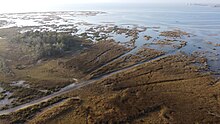
Back مستنقع ملحي Arabic नमकीन दलदल Bihari Palud sall Breton Schorre Catalan Slanisko Czech Morfa Welsh Forland Danish Salzwiese German Salmarĉo Esperanto Marisma salina Spanish


A salt marsh, saltmarsh or salting, also known as a coastal salt marsh or a tidal marsh, is a coastal ecosystem in the upper coastal intertidal zone between land and open saltwater or brackish water that is regularly flooded by the tides. It is dominated by dense stands of salt-tolerant plants such as herbs, grasses, or low shrubs.[1][2] These plants are terrestrial in origin and are essential to the stability of the salt marsh in trapping and binding sediments. Salt marshes play a large role in the aquatic food web and the delivery of nutrients to coastal waters. They also support terrestrial animals and provide coastal protection.[2]
Salt marshes have historically been endangered by poorly implemented coastal management practices, with land reclaimed for human uses or polluted by upstream agriculture or other industrial coastal uses. Additionally, sea level rise caused by climate change is endangering other marshes, through erosion and submersion of otherwise tidal marshes.[3][4] However, recent acknowledgment by both environmentalists and larger society for the importance of saltwater marshes for biodiversity, ecological productivity and other ecosystem services, such as carbon sequestration, have led to an increase in salt marsh restoration and management since the 1980s.
- ^ Adam, Paul (1990). Saltmarsh Ecology. New York: Cambridge University Press. ISBN 0-521-24508-7. OCLC 20217629.
- ^ a b Woodroffe, C. D. (2002). Coasts : form, process, and evolution. New York: Cambridge University Press. ISBN 0-521-81254-2. OCLC 48795910.
- ^ Simas, T; Nunes, J.P; Ferreira, J.G (March 2001). "Effects of global climate change on coastal salt marshes". Ecological Modelling. 139 (1): 1–15. Bibcode:2001EcMod.139....1S. doi:10.1016/S0304-3800(01)00226-5.
- ^ EPA (10 April 2014). "Climate Change in Coastal Environments". Retrieved 30 October 2023.